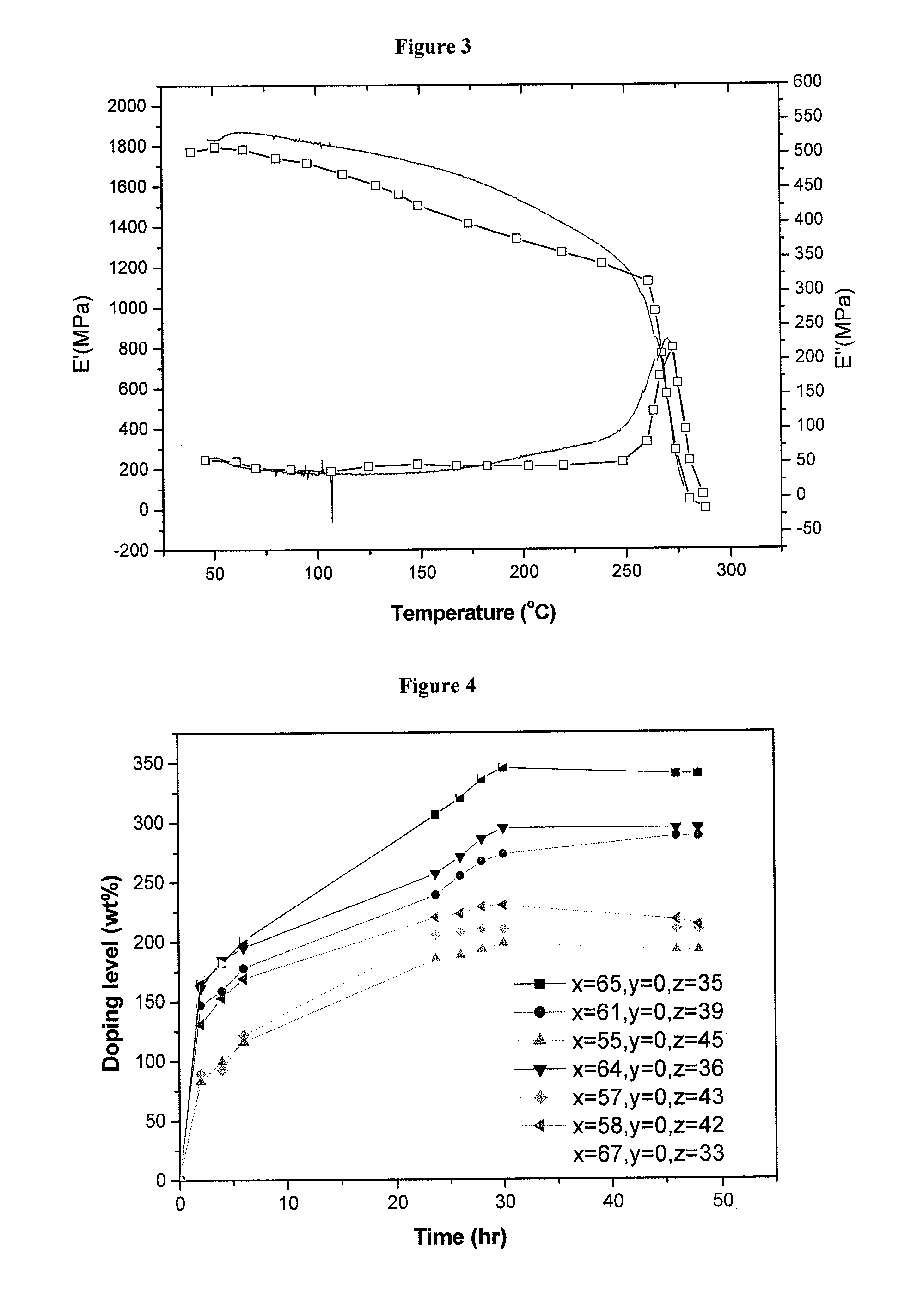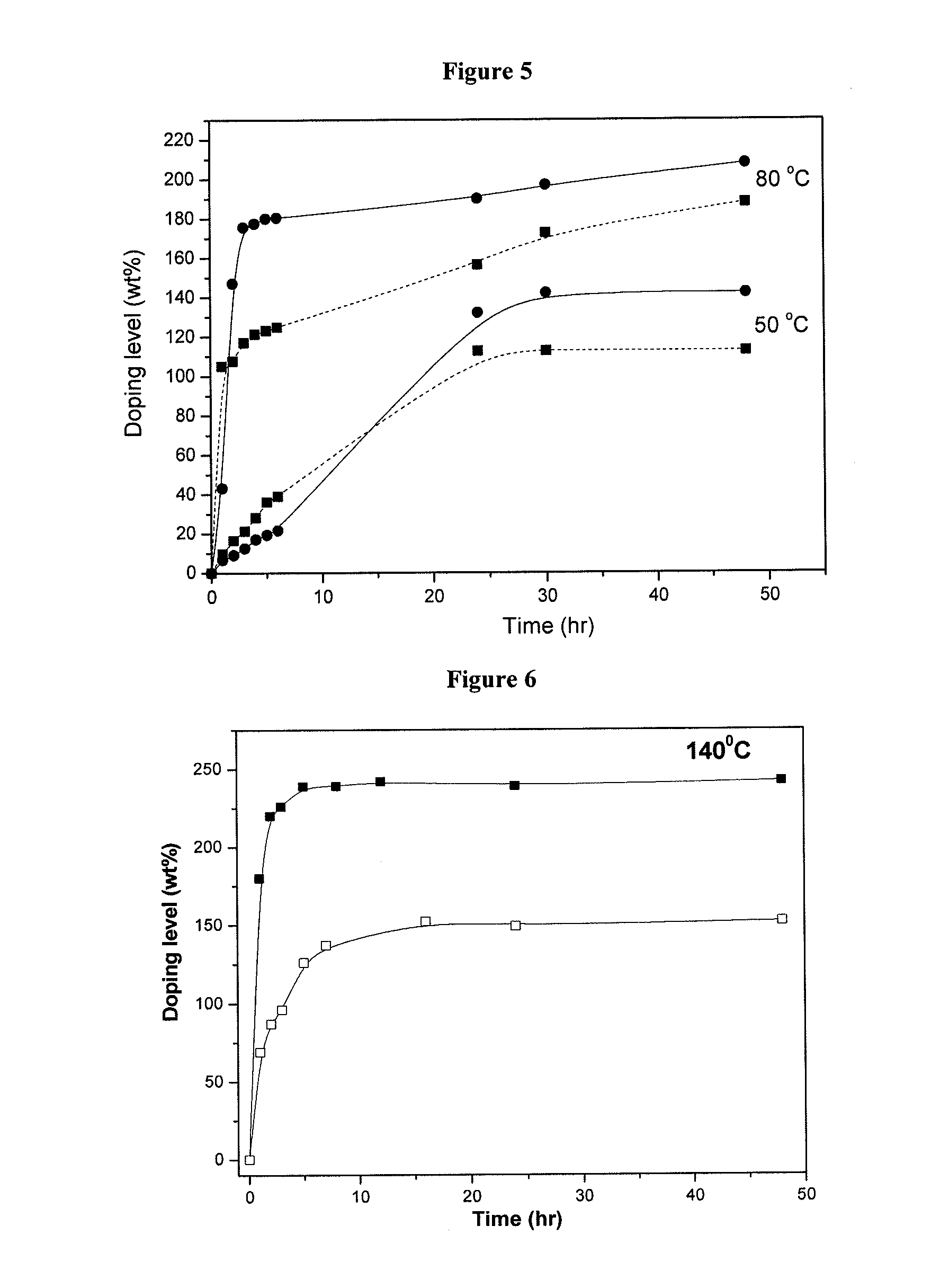Crosslinked or non-crosslinked aromatic (CO)polymers as proton conductors for use in high temperature PEM fuel cells
a proton conductor and aromatic polyether technology, applied in the field of aromatic polyethers for use, can solve the problems of deficient long-term durability, ineffective ionic cross-linking at higher temperatures, and loss of mechanical integrity of membranes, and achieve excellent mechanical properties and high thermal and oxidative stability
- Summary
- Abstract
- Description
- Claims
- Application Information
AI Technical Summary
Benefits of technology
Problems solved by technology
Method used
Image
Examples
example 1
Synthesis of Copolymer 1 with x=70, y=20, z=10
[0055]A degassed round bottom flask equipped with a Dean-Stark trap, was charged with bis(4-fluorphenyl)sulphone (5.9 mmol, 1.5 g), 2,5-bis(4-hydroxyphenyl)pyridine (3.54 mmol, 0.93 g), 3,3′,5,5′-tetramethyl-[1,1′-diphenyl]-4,4′-diol (1.77 mmol, 0.43 g) 3,5-dihydroxybenzoic acid (0.59 mmol, 0.09 g), K2CO3 (1.6 g). N-methylpyrrolidinone (25 mL) and toluene (5 mL). The mixture was heated at 150° C. for 24 h and at 180° C. for 48 h under inert argon atmosphere. The viscous solution was precipitated in HCl (0.01M). The precipitated copolymer 1 was filtered, washed several times with water and methanol and dried under high vacuum at 80° C. for 2 d.
example 2
Synthesis of Copolymer 2 with R═CH3 and x=70, y=0, z=30
[0056]To a degassed round bottom flask equipped with a Dean-Stark trap, bis(4-fluorophenyl)-sulfone (2.67 mmol, 0.6788 g), 2,5-bis(4-hydroxy-phenyl)pyridine (1.87 mmol, 0.49 g), 2,5-di(methyl phenyl)benzene-1,4-diacetate (0.801 mmol, 0.3 g), K2CO3 (3.1 mol, 0.427 g), KOH (2.67 mmol, 0.149 g), DMF (10 mL) and toluene (3 mL) were added. The mixture was heated at 150° C. for 24 h and at 180° C. for 48 h under inert argon atmosphere. The viscous product was diluted in DMF and this solution was precipitated in a 10 fold excess of 5 / 1 methanol / water mixture. The copolymer 2 was filtered, stirred in H2O at 60° C. for 2 h, filtered and washed with water and hexane and dried under high vacuum for 2 d at 80° C.
example 3
Membrane Fabrication and Doping Procedure
[0057]0.5 g of the copolymer 2 with R═CH3 (x=67) were diluted in 12 ml of DMA at room temperature. The solution was filtrated and was cast on a petri dish where the solvent slowly evaporated at 70° C. The resulting membrane was dried under vacuum at 160° C. for 3 days and then impregnated in H3PO4 85 wt % at 100° C.
PUM
| Property | Measurement | Unit |
|---|---|---|
| temperatures | aaaaa | aaaaa |
| temperature | aaaaa | aaaaa |
| temperatures | aaaaa | aaaaa |
Abstract
Description
Claims
Application Information
 Login to View More
Login to View More - R&D
- Intellectual Property
- Life Sciences
- Materials
- Tech Scout
- Unparalleled Data Quality
- Higher Quality Content
- 60% Fewer Hallucinations
Browse by: Latest US Patents, China's latest patents, Technical Efficacy Thesaurus, Application Domain, Technology Topic, Popular Technical Reports.
© 2025 PatSnap. All rights reserved.Legal|Privacy policy|Modern Slavery Act Transparency Statement|Sitemap|About US| Contact US: help@patsnap.com



